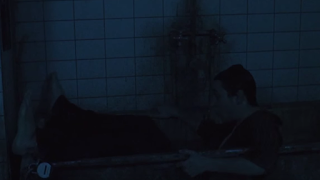As the film opening begins, the audience is shown the close up of a face, introducing him as a potential main character. The minimal lighting only allows the audience to see certain parts of his face. The light which travels across the man’s face makes clear of the dark, pitch black surrounding he is in, which is unnerving for the viewer, as it makes them unaware of what’s going on, putting them in the same position of the character. This creates a sense of uncertainty amongst the audience, as we are unable to see facial expression and if any damage has been caused. The diegetic sound of water gives off the impression that the character is drowning or has already died underwater.
The editing soon becomes very fast paced, flashing between the person in the bathtub and the plug hole. This gives the audience an idea of what the character is going through; the scene is chaotic and has high levels of action which is reflected through quick camera transitions. There is straight cutting to an object (a key) floating in the water and eventually going down the plug hole. The focus on this particular event makes the audience aware of the fact that it could play some sort of significance later on in the film.
There is a sudden shift from a close up camera shot into a long shot of the character waking up and escaping from the bath tub, allowing the audience to see him struggling. The fast cuts add to this, emphasising the danger and confusion the character is facing.§ As the camera transitions over, revealing more of the scenery the audience becomes more aware of the setting; he is in a dark, dirty room. The fact that he was in a bathtub makes clear that he is in some sort of abandoned bathroom. This choice of scenery as well as mise en scene puts the viewer on edge as, although it (a bathroom type setting) is a setting which we would normally be used to, its current state is off-putting and eerie as it is filthy and run-down.
The fast transition between the frame of the key travelling down the plug hole and the character escaping from the bath makes the audience aware that both focuses have some sort of significance and importance whether it is in the current moment or later on in the film, thus becoming memorable for the viewers.
A long shot frame shows the character fully exiting the bathtub. We see the man fall over, as he is unaware of the fact that he has a chain locked around his lower leg- something that the audience could see whilst he first woke up. This shows that the character is just as confused and unaware of what situation he is in as the audience is. The very dark lighting allows us to see the character begin to fumble around, as he has been blinded by the lack of light around him.








No comments:
Post a Comment